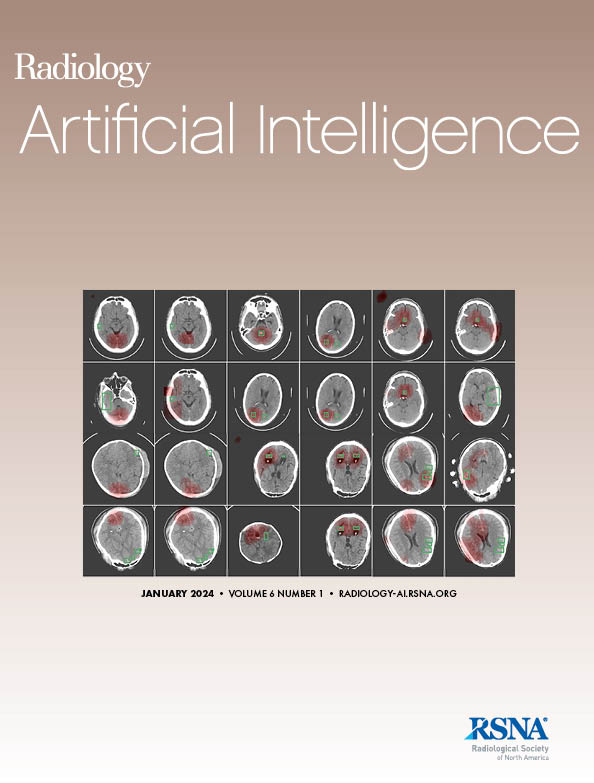Using Explainable AI to Characterize Features in the Mirai Mammographic Breast Cancer Risk Prediction Model.
IF 13.2
Q1 COMPUTER SCIENCE, ARTIFICIAL INTELLIGENCE
Yao-Kuan Wang, Zan Klanecek, Tobias Wagner, Lesley Cockmartin, Nicholas Marshall, Andrej Studen, Robert Jeraj, Hilde Bosmans
求助PDF
{"title":"Using Explainable AI to Characterize Features in the Mirai Mammographic Breast Cancer Risk Prediction Model.","authors":"Yao-Kuan Wang, Zan Klanecek, Tobias Wagner, Lesley Cockmartin, Nicholas Marshall, Andrej Studen, Robert Jeraj, Hilde Bosmans","doi":"10.1148/ryai.240417","DOIUrl":null,"url":null,"abstract":"<p><p>Purpose To evaluate whether features extracted by Mirai can be aligned with mammographic observations, and contribute meaningfully to the prediction. Materials and Methods This retrospective study examined the correlation of 512 Mirai features with mammographic observations in terms of receptive field and anatomic location. A total of 29,374 screening examinations with mammograms (10,415 women, mean age at examination 60 [SD: 11] years) from the EMBED Dataset (2013-2020) were used to evaluate feature importance using a feature-centric explainable AI pipeline. Risk prediction was evaluated using only calcification features (CalcMirai) or mass features (MassMirai) against Mirai. Performance was assessed in screening and screen-negative (time-to-cancer > 6 months) populations using the area under the receiver operating characteristic curve (AUC). Results Eighteen calcification features and 18 mass features were selected for CalcMirai and MassMirai, respectively. Both CalcMirai and MassMirai had lower performance than Mirai in lesion detection (screening population, 1-year AUC: Mirai, 0.81 [95% CI: 0.78, 0.84], CalcMirai, 0.76 [95% CI: 0.73, 0.80]; MassMirai, 0.74 [95% CI: 0.71, 0.78]; <i>P</i> values < 0.001). In risk prediction, there was no evidence of a difference in performance between CalcMirai and Mirai (screen-negative population, 5-year AUC: Mirai, 0.66 [95% CI: 0.63, 0.69], CalcMirai, 0.66 [95% CI: 0.64, 0.69]; <i>P</i> value: 0.71); however, MassMirai achieved lower performance than Mirai (AUC, 0.57 [95% CI: 0.54, 0.60]; <i>P</i> value < .001). Radiologist review of calcification features confirmed Mirai's use of benign calcification in risk prediction. Conclusion The explainable AI pipeline demonstrated that Mirai implicitly learned to identify mammographic lesion features, particularly calcifications, for lesion detection and risk prediction. ©RSNA, 2025.</p>","PeriodicalId":29787,"journal":{"name":"Radiology-Artificial Intelligence","volume":" ","pages":"e240417"},"PeriodicalIF":13.2000,"publicationDate":"2025-09-03","publicationTypes":"Journal Article","fieldsOfStudy":null,"isOpenAccess":false,"openAccessPdf":"","citationCount":"0","resultStr":null,"platform":"Semanticscholar","paperid":null,"PeriodicalName":"Radiology-Artificial Intelligence","FirstCategoryId":"1085","ListUrlMain":"https://doi.org/10.1148/ryai.240417","RegionNum":0,"RegionCategory":null,"ArticlePicture":[],"TitleCN":null,"AbstractTextCN":null,"PMCID":null,"EPubDate":"","PubModel":"","JCR":"Q1","JCRName":"COMPUTER SCIENCE, ARTIFICIAL INTELLIGENCE","Score":null,"Total":0}
引用次数: 0
引用
批量引用
Abstract
Purpose To evaluate whether features extracted by Mirai can be aligned with mammographic observations, and contribute meaningfully to the prediction. Materials and Methods This retrospective study examined the correlation of 512 Mirai features with mammographic observations in terms of receptive field and anatomic location. A total of 29,374 screening examinations with mammograms (10,415 women, mean age at examination 60 [SD: 11] years) from the EMBED Dataset (2013-2020) were used to evaluate feature importance using a feature-centric explainable AI pipeline. Risk prediction was evaluated using only calcification features (CalcMirai) or mass features (MassMirai) against Mirai. Performance was assessed in screening and screen-negative (time-to-cancer > 6 months) populations using the area under the receiver operating characteristic curve (AUC). Results Eighteen calcification features and 18 mass features were selected for CalcMirai and MassMirai, respectively. Both CalcMirai and MassMirai had lower performance than Mirai in lesion detection (screening population, 1-year AUC: Mirai, 0.81 [95% CI: 0.78, 0.84], CalcMirai, 0.76 [95% CI: 0.73, 0.80]; MassMirai, 0.74 [95% CI: 0.71, 0.78]; P values < 0.001). In risk prediction, there was no evidence of a difference in performance between CalcMirai and Mirai (screen-negative population, 5-year AUC: Mirai, 0.66 [95% CI: 0.63, 0.69], CalcMirai, 0.66 [95% CI: 0.64, 0.69]; P value: 0.71); however, MassMirai achieved lower performance than Mirai (AUC, 0.57 [95% CI: 0.54, 0.60]; P value < .001). Radiologist review of calcification features confirmed Mirai's use of benign calcification in risk prediction. Conclusion The explainable AI pipeline demonstrated that Mirai implicitly learned to identify mammographic lesion features, particularly calcifications, for lesion detection and risk prediction. ©RSNA, 2025.
使用可解释的AI来描述Mirai乳房x线摄影乳腺癌风险预测模型中的特征。
“刚刚接受”的论文经过了全面的同行评审,并已被接受发表在《放射学:人工智能》杂志上。这篇文章将经过编辑,布局和校样审查,然后在其最终版本出版。请注意,在最终编辑文章的制作过程中,可能会发现可能影响内容的错误。目的评价Mirai提取的特征是否能与乳房x线摄影观察相一致,并为预测做出有意义的贡献。材料和方法回顾性研究了512种Mirai特征与乳腺x线摄影观察的感受野和解剖位置的相关性。来自EMBED数据集(2013-2020)的29,374例乳房x线筛查检查(10,415名女性,检查时平均年龄60 [SD: 11]岁)被用于使用以特征为中心的可解释AI管道评估特征重要性。仅使用钙化特征(CalcMirai)或肿块特征(MassMirai)对Mirai进行风险预测。使用受者工作特征曲线(AUC)下的面积评估筛查和筛查阴性人群(至癌时间为6个月)的表现。结果CalcMirai和MassMirai分别选择了18个钙化特征和18个肿块特征。CalcMirai和MassMirai在病变检测方面的表现均低于Mirai(筛查人群,1年AUC: Mirai 0.81 [95% CI: 0.78, 0.84], CalcMirai 0.76 [95% CI: 0.73, 0.80], MassMirai 0.74 [95% CI: 0.71, 0.78], P值< 0.001)。在风险预测方面,没有证据表明CalcMirai和Mirai之间的表现有差异(筛查阴性人群,5年AUC: Mirai, 0.66 [95% CI: 0.63, 0.69], CalcMirai, 0.66 [95% CI: 0.64, 0.69], P值:0.71);然而,MassMirai的性能低于Mirai (AUC, 0.57 [95% CI: 0.54, 0.60]; P值< 0.001)。放射科医师对钙化特征的回顾证实了Mirai良性钙化在风险预测中的应用。结论可解释的AI管道表明Mirai隐式学习识别乳房x线病变特征,特别是钙化,用于病变检测和风险预测。©RSNA, 2025年。
本文章由计算机程序翻译,如有差异,请以英文原文为准。
来源期刊
期刊介绍:
Radiology: Artificial Intelligence is a bi-monthly publication that focuses on the emerging applications of machine learning and artificial intelligence in the field of imaging across various disciplines. This journal is available online and accepts multiple manuscript types, including Original Research, Technical Developments, Data Resources, Review articles, Editorials, Letters to the Editor and Replies, Special Reports, and AI in Brief.

 求助内容:
求助内容: 应助结果提醒方式:
应助结果提醒方式:


